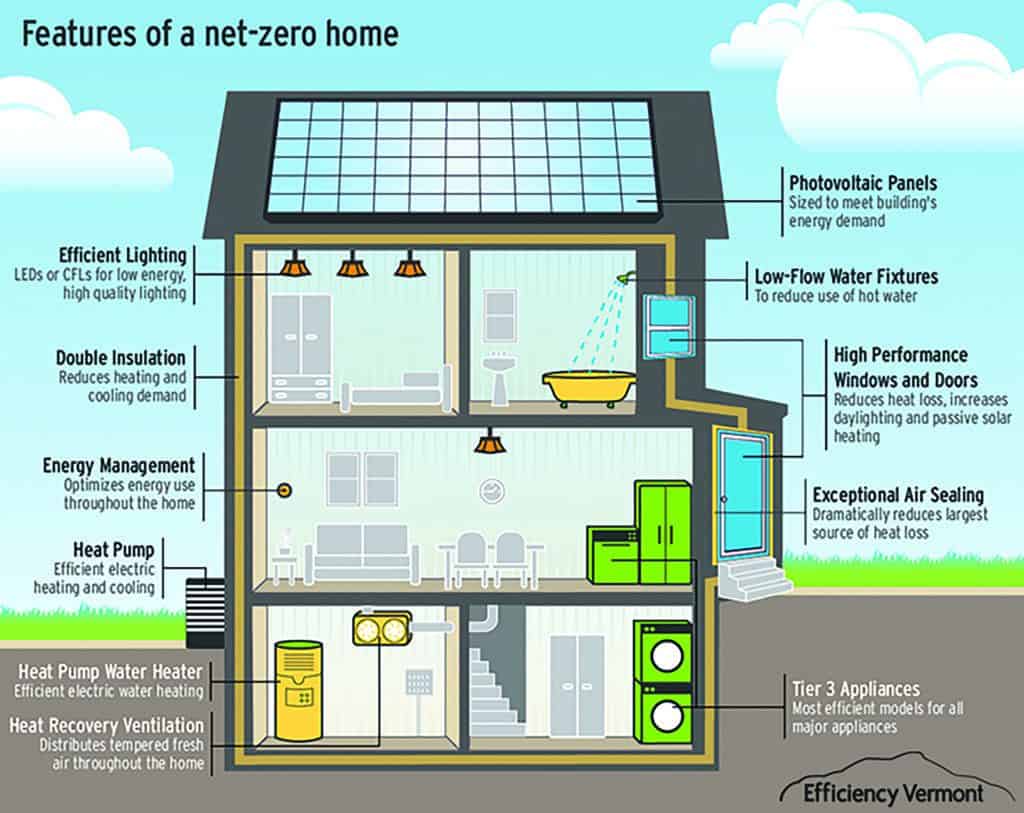
Five years ago, Karen Correll and her husband David were already on the path to make their Rutland home net zero, but they didn’t know it at the time. (Net zero is the balance between the power a home needs and the renewable energy you can generate to match the need). With new heating technology and lower-cost renewable energy systems, any home can get to net zero.
The Correll’s starting point was an offer from Green Mountain Power to complete an energy audit and a blower door test to see how they could save energy in their home.
They weren’t sure what they would find, but they were hopeful. Their home was using around 800 gallons of fuel oil a year at the time – Karen recalls it costing over $3,000 per year to heat the home. “I hate having the furnace on,” Karen said recently.
Green Mountain Power recommended two solutions to the Corrells: 1) install a cold climate heat pump to reduce their reliance on the furnace; and 2) complete a comprehensive weatherization project to keep more of the heat they were using inside the home and make it more comfortable.
These weren’t the first steps they’d taken on the Path to Net Zero. They’d started replacing their incandescent lightbulbs with LEDs several years before. When they’d made those changes, and when they decided to move forward on the heat pump installation and the weatherization project, it wasn’t with a goal of going net zero. It was about knowing they’d pay less and be more comfortable.
“We weren’t on a mission to go green, necessarily. But that has been an added bonus of the work we did,” said Karen. “We just wanted a more comfortable home that we could enjoy while lowering the cost of living in Vermont.”
Karen connected with Efficiency Vermont to identify a qualified contractor in its Efficiency Excellence Network. The reached out to Vermont Energy Works, who, in addition to adding insulation in the basement and attic and air sealing the entire building, also recommended installing a programmable thermostat to help manage the two heat sources and keep the home at a comfortable temperature. They also recommended replacing an older, less efficient bathroom fan with a newer model. The more efficient ventilation would help keep the air fresh once the home was tighter.
Karen never looked back. The year after the projects were completed, the home used just 150 gallons of fuel oil. That’s a lot of savings, but the big takeaway? “We’re comfortable in our home. We feel the difference every day – it’s the best thing we did.”
Because heat pumps work most efficiently when you don’t adjust the temperature too often (the “set it and forget it” model), their is house warmer than it was with the furnace alone. And the weatherization keeps that heat inside so even though it’s warmer, it’s burning less fossil fuel.
The biggest surprise for the Corells came the next summer. Karen and David had gotten used to carting in a window air conditioner every summer to keep their home livable in the hottest months of the year. That year, they left the heat pump on.
“The humidity dropped immediately – it was so comfortable! And the cool air from the heat pump makes the house a great reprieve from the heat.”
They were convinced. Karen and David decided to reduce their fuel bill as much as they could by replacing their water heater with a heat pump water heater. In addition to saving on fuel, the heat pump water heater allowed them to get rid of the dehumidifier they’d had to keep in the basement previously. Now they’re unexpectedly able to dry clothes on a rack in the basement using the dehumidifying effect of the heat pump water heater. And it’s not just heating – the couple looks for energy saving opportunities by seeking out ENERGY STAR® appliances whenever they need a replacement.
What’s next for Karen and David? “We really want to eliminate the furnace entirely. We hope to add a second heat pump that expands the heat to the upstairs. It’ll be a great day when we can eventually remove both the furnace and the fuel tank from the house altogether.”
While Efficiency Vermont still recommends keeping a back-up heating system when you have heat pumps, by taking advantage of Green Mountain Power’s renewable grid (already 60% renewable and 90% carbon free), the Corrells are well on their way down the path to net zero.




